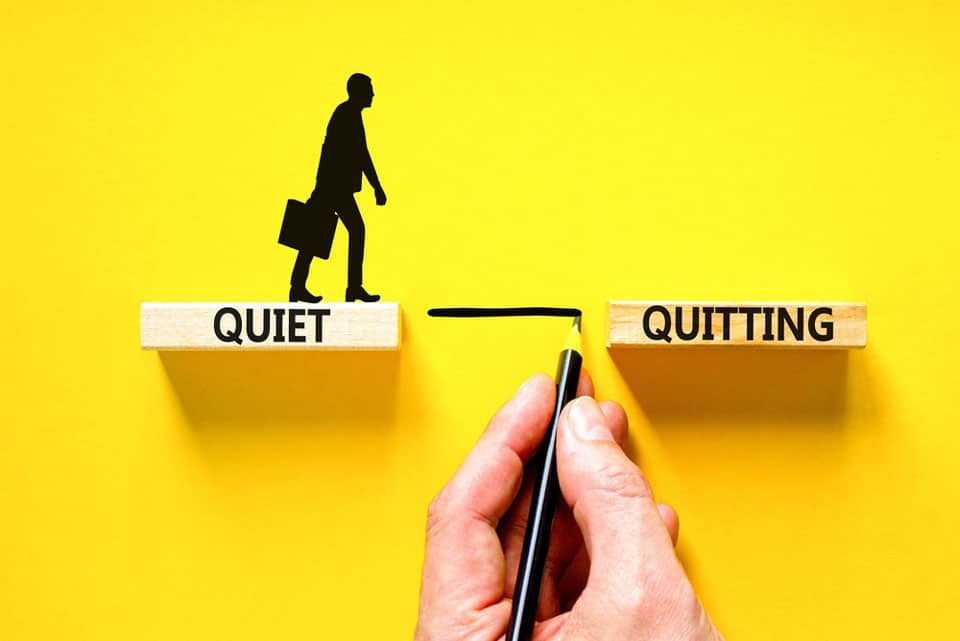The Forced Return to Office Leads to Quiet Quitting

The term “quiet quitting” emerged in March 2022, and refers to doing the bare minimal tasks of your job description well enough that you don’t get fired. The concept quickly went viral on TikTok.
Yet it only started to gain traction as an issue of concern among business leaders when government data on productivity released in August 2022 showed a sharp and unexpected drop in Q1 and Q2 of 2022. Soon after that worrisome datapoint in August, Gallup released a survey in early September indicating that as many as half of all Americans may be quiet quitters, further exacerbating business leadership concerns about this problem.
Is Remote Work Responsible for Quiet Quitting?
Many traditionalist leaders rushed to attribute this drop in productivity and rise in quiet quitting to remote work. For example, BlackRock CEO Larry Fink attributed the drop in productivity to remote work. He called for requiring employees to come to the office to address this problem.
Yet the claims of traditionalists don’t add up. If quiet quitting and the resultant drop in productivity stemmed from remote work, we should see a drop in productivity right from the start of the pandemic, when office workers switched to remote work. Then, when offices opened back up, especially after the Omicron wave in the end of 2021, we should see productivity going up as workers went back to the office from early 2022 onward.
In reality, we see the opposite trend. US productivity jumped in Q2 2020 as offices closed, and stayed at a heightened level through Q4 2021. Then, when companies started mandating a return to office from early 2022, productivity dropped sharply.

So what explains the drop in productivity associated with quiet quitting? According to Ben Wigert, director of research and strategy for workplace management at Gallup, forcing employees to come to the office under the threat of discipline leads to disengagement, fear, and distrust. Gallup finds that “the optimal engagement boost occurs when employees spend 60% to 80% of their time—or three to four days in a five-day workweek—working off-site.” The Integrated Benefits Institute found in an October 2022 survey that employees who work remotely or in a hybrid environment reported being more satisfied (20.7%) and more highly engaged (50.8%).
No wonder, then, that mandates forcing employees to come to the office result in quiet quitting. Disengaged workers aren’t productive. That’s especially the case if they’re looking for a new job: the career website Monster reported that two-thirds of survey respondents would quit rather than return to the office full time. Not surprisingly, many of those who are forced to return to the office start polishing their resumes and meeting with recruiters.
Solving Quiet Quitting in the Mandated Return to Office
When I show this data to my consulting clients, they often ask me what they can do to address this problem. First of all, I remind them of a joke from the famous comedian Henny Youngman: “The patient says, ‘Doctor, it hurts when I do this.’ The doctor says, ‘Then don’t do that!’’’ The best approach for the future of work is a flexible team-led approach, where team leads make the call on work arrangements that serve the needs of their team. Team leads know best what their teams need, including how to maximize productivity, engagement, and collaboration.
However, often it’s not so easy. They might be facing an intransigent Boards of Directors, or the rest of the C-suite might be united in demanding employees return to the office for much or all of the workweek. What then?
In that case, I help them figure out best practices for returning to the office that minimize quiet quitting concerns. You might imagine that it’s as simple as paying people more. And indeed, a conversation about compensation should always accompany a return to office initiative. For instance, research by Owl Labs suggests that it costs an average of $863/month for the average office worker to commute to work versus staying at home, which is about $432/month for utilities, office supplies, and so on.
What I find works best is to pay for fees associated with specific office-related costs, rather than a general salary increase. Thus, pay the commuting costs of your staff: IRS per diem for miles traveled, public transport fees, and so on. Pay for a nice catered lunch. Pay for their dry-cleaning costs.
Such payments help address the initial discontent and reduce the attrition typically associated with the mandated office return. But they don’t address the quiet quitting that results from people coming to the office and doing the same thing they would do at home, except with a two-hour commute.
An October 2022 survey by Slack found that many knowledge workers who are required to go back to the office are spending up to four hours on video calls. Slack’s head in the UK Stuart Templeton said that employers risked turning their offices into “productivity killers,” since “making a two-hour commute to sit on video calls is a terrible use of the office.”
That’s the kind of thing that leads directly to quiet quitting. We know that people are much more productive on individual tasks that require focus at home. The survey by Slack confirmed this impression: 55% of respondents preferred to do “deep work” at home, and only 16% cited the office as a better place for deep work.
Instead, the office should be a place for socializing, collaboration, and in-depth training, especially for newer employees. To address socializing needs, it’s valuable to organize fun team-building exercises and social events as staff come back to the office.
To facilitate collaboration, it’s important to consider how in-office staff work together with those working from home. A number of my clients have staff who come in on different days of the week, requiring hybrid collaboration and meetings. To facilitate such collaboration of in-office and remote staff, it helps to provide virtual office environments, which put both kinds of workers on an equal playing field. Likewise, it’s imperative to improve AV to facilitate hybrid meetings to enable effective collaboration.
There’s no replacement for face-to-face experiences for in-depth training around soft skills, such as effective in-person communication, conflict mediation and resolution, and ethical persuasion. My clients find that if they offer valuable training regularly once their employees return to the office, there’s a reduction in quiet quitting and a boost in employee engagement and productivity.
Finally, we find it’s valuable to help staff address burnout as part of the return to office, such as by providing mental health benefits. In a late 2022 Gallup survey, 71% of respondents said that compared to in-office work, hybrid work improves work-life balance and 58% reported less burnout.
While a mandated return to office will inevitably lead to some quiet quitting and loss in productivity, smart leaders can ameliorate this problem using best practices. Focusing on helping employees socialize, collaborate, and get great professional development and mentoring, and thus showing them the value of the office, will reduce quiet quitting and boost performance.
Written by Dr. Gleb Tsipursky.
Have you read?
Heavyweights Call Emil Michael the Master of Dealmaking. Here’s How He Does It.
People leave managers, not organizations – the important role managers play in retention by Dr. Dominic Mcloughlin.
The Business Case for Leaders Promoting the New Boosters by Dr. Gleb Tsipursky.
Is It Time to Rethink Paid Time Off by Frank Watanabe.
Bring the best of the CEOWORLD magazine's global journalism to audiences in the United States and around the world. - Add CEOWORLD magazine to your Google News feed.
Follow CEOWORLD magazine headlines on: Google News, LinkedIn, Twitter, and Facebook.
Copyright 2025 The CEOWORLD magazine. All rights reserved. This material (and any extract from it) must not be copied, redistributed or placed on any website, without CEOWORLD magazine' prior written consent. For media queries, please contact: info@ceoworld.biz








